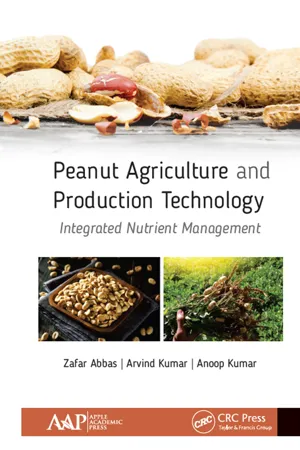
Peanut Agriculture and Production Technology
Integrated Nutrient Management
- 204 pages
- English
- ePUB (mobile friendly)
- Available on iOS & Android
Peanut Agriculture and Production Technology
Integrated Nutrient Management
About This Book
Peanut Agriculture and Production Technology: Integrated Nutrient Management focuses on agricultural techniques and integrated nutrient management of peanuts ( Arachis hypogaea L.). Peanuts are the second most important oil crop of India, occupying 5.7 million hectares, with an average production of 0.8 ton/ha, which is 23.5% of the India's total oil seed production. Worldwide annual production of shelled peanuts was 42 million metric tons in 2014. It is the world's 4th most important source of edible oil and the 3rd most important source of vegetable protein.
The volume includes basic and advanced information on production, agrotechniques, and integrated nutrient management of Arachis hypogaea L. crop plant. It studies the physiology of the peanut, looking at the proper environmental conditions for optimal growth as well as under various subnormal conditions. It explores the methods of nitrogen application as well as the influence of different sowing dates and population densities to harvest its full yield potential. The book covers methods to achieve balanced nutrition, including using organic manures in groundnut farming to enhance yielding ability.
The book will be a rich resource for those in agriculture, horticulture, and allied sciences, particularly for agricultural scientists in plant and crop physiology, agronomy, and soil science. Farm owners and managers of peanut crops and production will also benefit from the information provided in this volume.
Frequently asked questions
Information
Nutritional value of groundnut per 100 g (3.5 oz) | |
Energy | 2,385 kJ (570 kcal) |
Carbohydrates | 21 g |
Sugars | 0.0 g |
Dietary fiber | 9 g |
Fat | 48 g |
Saturated | 7 g |
Monosaturated | 24 g |
Polyunsaturated | 16 g |
Protein | 25 g |
Tryptophan | 0.2445 g |
Threonine | 0.859 g |
Isoleucine | 0.882 g |
Leucine | 1.627 g |
Lysine | 0.901 g |
Methionine | 0.308 g |
Cystine | 0.322 g |
Phenylalanine | 1.300 g |
Tyrosine | 1.020 g |
Valine | 1.052 g |
Arginine | 3.001 g |
Histidine | 0.634 g |
Alanine | 0.997 g |
Aspartic acid | 3.060 g |
Glutamic acid | 5.243 g |
Glycine | 1.512 g |
Proline | 1.107 g |
Serine | 1.236 g |
Vitamins | |
Thiamine (B1) | 0.6 mg |
Riboflavin (B2) | 0.3 mg |
Niacin (B3) | 12.9 mg |
Pantothenic acid | 1.8 mg |
Vitamin B6 | 0.3 mg |
Folate (B9) | 246 ug |
Vitamin C | 0.0 mg |
Vitamin E | 6.6 mg |
Minerals | |
Calcium | 62 mg |
Iron | 2 mg |
Magnesium | 184 mg |
Manganese | 2.0 mg |
Phosphorus | 336 mg |
Potassium | 332 mg |
Zinc | 3.3 mg |
Other constituents | |
Water | 4.26 g |
http://ndb.nal.usda.gov/ndb/foods/show/4831.
Rank | Countries | Production |
1 | China | 17.0 |
2 | India | 9.5 |
3 | Nigeria | 3.0 |
4 | United States | 1.9 |
5 | Myanmar | 1.4 |
Total | World | 46 |
Table of contents
- Cover
- Half Title
- Title Page
- Copyright Page
- Table of Contents
- About the Authors
- List of Abbreviations
- Foreword
- Preface
- 1. Introduction
- 2. Integrated Nutrient Management
- References
- Index